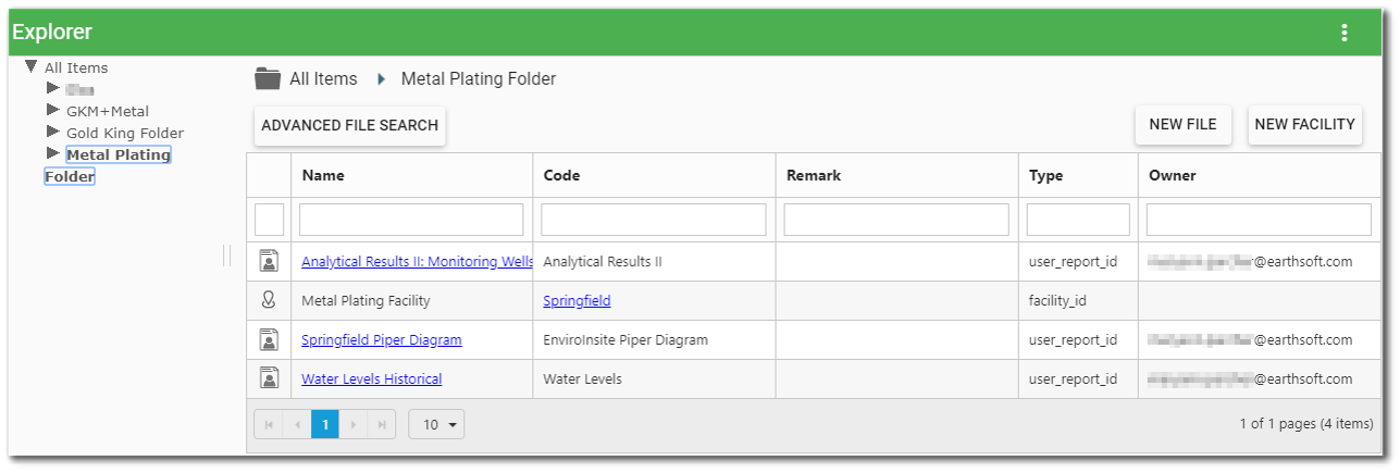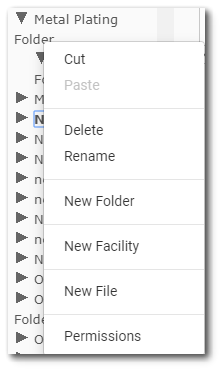The Explorer Widget is used to browse, search, and organize EQuIS database objects within folders. Users have the ability to create folders to group objects. This widget can also be used to create new files and facilities as well as edit or delete files from the database.
Widget Interface
The Explorer widget is divided into sections, as depicted in the image below:
•Tree of all file folders and contents (left pane)
•Information grid (main pane)
•Top frame above the grid that displays an interactive folder path and contains buttons for Advanced File Search, New File, and New Facility options
•Paging control beneath the grid
On the left is the Folder Tree section of the widget, where the existing folder structures are displayed. The Folder Tree pane can be resized by dragging the || icon with the mouse.
Clicking the folder name populates the information grid with the contents of that folder. The interactive folder path above the grid will also update. To display any sub-folders, click the arrow icon. Objects can be dragged and dropped from one folder into another. To create a new folder, right-click on a folder in the left panel and select New Folder from the context menu. Objects can be moved into the new folder by administrator users. The folders can be accessed in other widgets where the folder icon is visible (e.g., the EZView widget) for selecting/grouping reports.
Note: If folders that are part of a group are not visible, check RT_GROUP.STATUS_FLAG to ensure it is set to 'A' for that group. |
|---|
The Explorer widget displays a grid that lists all objects in the selected folder as well as the attributes of the object. The icons indicate the object type. The object attributes include name, code, remark, type, and owner. The following table details the attributes displayed in the grid by object type, except for the Remark field, which is an optional field for any of the object types.
Icon |
Name |
Code |
Type |
Owner |
|---|---|---|---|---|
|
Dashboard Title |
Dashboard Title |
DASHBOARD_ID |
Creator of Dashboard |
|
Facility Name |
Facility Code |
FACILITY_ID |
Facility Project Manager |
|
File Title |
File Name |
FILE_ID |
File Author |
|
For user reports, this is the Report Name.
For base (build) reports, this is the Report Display Name. |
For user reports, this is the base report specific name of the report.
For base (build) reports, this is the specific name of the report. |
USER_REPORT_ID
REPORT_ID |
If created in Enterprise, the creator of the user report. Otherwise left blank. |
|
Widget Type Name |
Widget Type Name |
WIDGET_TYPE_ID |
N/A |
The grid columns of the Explorer widget can be sorted or filtered based on these object attributes.
Sorting – The columns are sortable by clicking on the column header (click again to reverse the sort). Note that sorting does not change the current page, and the first or last values of the sorted column may not be displayed, unless on the first or last page of the list.
Filtering – To filter the attributes, enter a search term (three or more characters) in the appropriate search box beneath the column header. Note that there is a three (3) character minimum on search strings by design; searching one or two characters will not return results. Only attributes that contain the search term will be displayed.
Tip: Files loaded to EQuIS via a format file or in Professional may not have a "Title" value, which is what is displayed in the Name column in the grid. Thus, filtering and/or sorting on the Code column, which contains the file name, may yield better results for file objects. |
The widget contains a Layout Divider indicated by the two parallel bars || that can be dragged to resize the tree and grid portions of the widget. Each of the columns in the information grid can also be resized by dragging along the column dividers.
The bottom of the widget contains paging controls for displaying a limited number of items at a time, as described below.
Arrows – Use the left/right arrows to navigate through pages.
Go to Page List – Select a specific page to navigate directly to that page.
Rows per Page – Change the number of items to be displayed per page by using the drop-down menu.
Count of Pages and Total Items – This control indicates the total number of items available in the widget, how many pages to display the items, and which page is currently selected.
Context Menu
If a user is an administrator, a context menu is available when a node in the folder tree is right-clicked, as shown below. This includes the following options:
Cut and Paste – Cut will remove a folder from the tree after it is pasted. Paste will insert a folder or a grid object into the right-clicked folder. Delete – After clicking Yes on the confirmation window, this will delete the right-clicked folder. Rename – Gives the ability to rename the folder's display text in a pop-up window. New Folder – Allows the user to create a new folder within the currently selected folder. Right-click on the root folder to create a top-level folder. New Facility – Opens the New Facility window. This is the same as clicking on the New Facility button in the widget header, except that the new facility will be inserted into the right-clicked folder. Permissions – Opens a permissions window to set the right-clicked folder's permissions. The administrator will be able to grant or deny different permissions to users or roles. |
|
A context menu is also available on the objects listed in the information grid by right-clicking in any column of the row for the object. If the user has appropriate permissions, this context menu will include Cut, Paste, Delete, and/or Permissions.
Cut and Paste – Cut will remove the object after it is pasted. Paste will insert the object into the currently selected folder in the Explorer tree.
Delete – If the grid object is a user report, dashboard or file and the user has owner permission on the report, dashboard or file, this option will be available. For a user report, clicking this option will remove the report from Enterprise, although it will remain in the database (with the STATUS_FLAG set to R). If the report is associated with an EIA, the delete action will fail, and a message will be displayed. If a file is deleted via the Explorer Widget, the file will be removed from the database tables. After clicking Yes on the confirmation window, this will delete the file from EQuIS.
Permissions – If the user is an administrator, this option will be available. This opens up the permissions dialog allowing an administrator the ability to grant/deny permission on the selected object to a user or a role.
Drag and Drop
Administrators as well as non-admin users, given they have sufficient permission, can drag and drop one or more objects from one folder into another. If the user is a non-admin, they need to have Owner permission on the following: Object(s) being moved, source group from which the object(s) are being moved, and target group to which the object(s) are being placed. If the user has insufficient permissions, an alert will inform the user where they do not have sufficient permissions and will not execute the changes.
New Facility
The New Facility button can be clicked to create a new facility. A New Facility window opens that can be completed with the desired settings. The Facility Code is a required field, but all other parameters are optional and can be updated later after the facility has been created. Hover over the field to display a tooltip containing the maximum number of characters allowed.
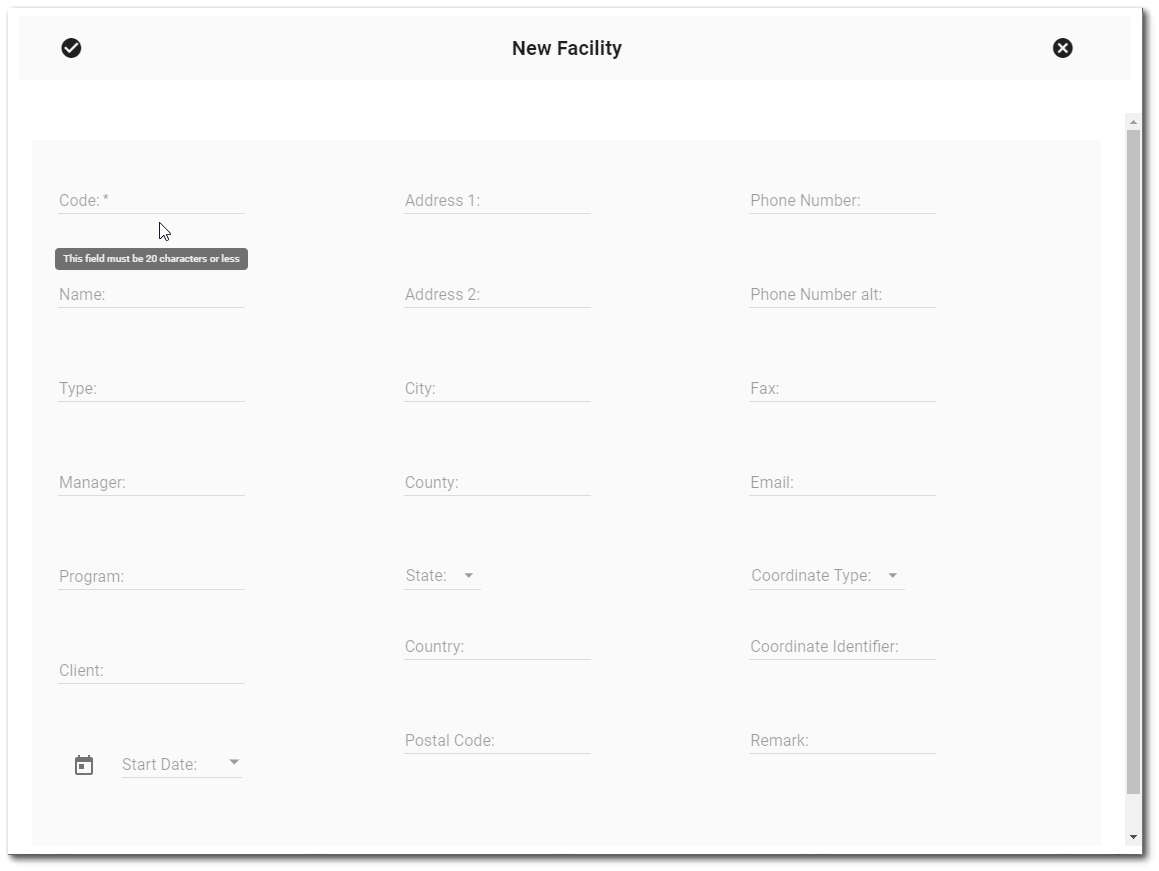
File Functionality
The Explorer widget can be used to create new files as well as edit or delete existing files from the database. Each file and its associated meta data are stored in the DT_FILE table. The file metadata can also be edited in the Explorer widget. The default metadata associated with files in the Explorer widget are described in the following section (Upload a Single File). Additional file metadata parameters may also be available if custom file metadata parameters have been defined in the RT_FILE_PARAM_TYPE table.
Upload a Single File
Click the New File button to upload a single new file. An Upload File window opens that can be completed with the desired settings. This button is only available to users that have creator permission on the file type object. The upload file will be associated with the session facility .

The Upload File window includes the following default file metadata options. Additional file metadata parameters may be displayed in the Upload File window if custom file metadata parameters have been defined in the RT_FILE_PARAM_TYPE table. The file object can link to an external file source instead of being stored in EQuIS. DT_FILE.CONTENT holds either the actual file in binary form, or a link file (.uri) that includes the external location and, optionally, any file content search text.
Save To – Allows user to select a folder to save the file. Defaults to the All Items root folder if no folder is selected. The user needs at least editor permission on the folder selected to save the file.
Title – Title for the file stored in DT_FILE.TITLE. This is a required field.
Author – Name of file author stored in DT_FILE.AUTHOR. This field is optional.
Remark – A description of the file stored in DT_FILE.REMARK. This field is optional.
Object EUID – Users can set and edit the DT_FILE.OBJECT_EUID value to facilitate document management.
Location – Select a location from the drop-down list to associate the file with that location, which results in DT_FILE.PLACE_TYPE = SYS_LOC_CODE and DT_FILE.PLACE_CODE = {SYS_LOC_CODE value of the location} (e.g., B-30). The locations displayed in the drop-down menu will be for the selected Facility session. This field is optional. If left blank, no values are assigned related to location in the DT_FILE table.
Date – The DT_FILE.FILE_DATE field will automatically populate with the date the file is upload if a date is not selected. Use the calendar tool to select a past date to assign to the file to denote when the file was created rather than uploaded. The required date format is YYYY-MM-DD (ISO 8601 standard).
Confidential (Y/N) – Use the radio buttons to mark the file as confidential. This value is optional and stored in DT_FILE.FILE_CONFIDENTIAL_YN.
File Source – Allows user to select a local file or use a URL (i.e., Internet option). The file name or URL is stored in DT_FILE.FILE_NAME.
•Local File – Select the file to upload by browsing to the file or by dragging and dropping it. An Upload Box will appear. This box displays the name, size and status of the file being uploaded. Click the Upload button. If the file is successfully uploaded, the Upload Box will display a white check mark within a green circle under the Status column. Select the Close button to exit this box.
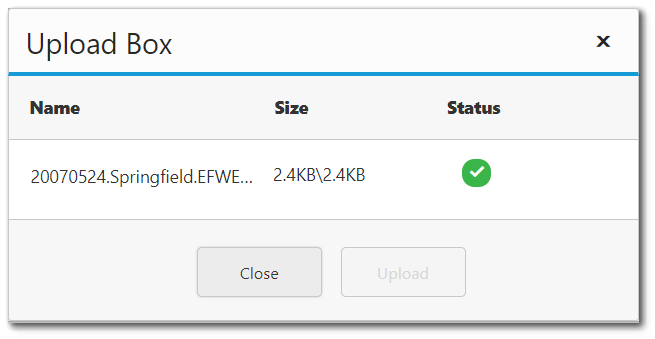
•Internet – Enter the URL where the file is located. An internet file can be uploaded via Redirect or using EQuIS as a Proxy. When a file is uploaded as a redirect and a user selects the file name from the Explorer grid, a new browser tab will open that takes the user to the URL of the file. The file will be displayed in the browser tab. When a file is uploaded as a proxy and a user selects the file name from the Explorer grid, a new browser tab will temporarily open with the Enterprise site's URL. The file will be download from the Enterprise server and the tab will be closed.
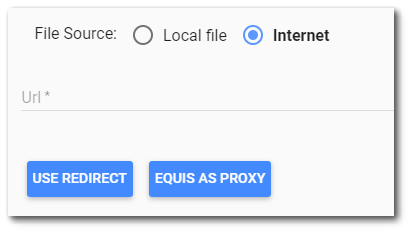
Batch Upload Files
While the New File button on the Explorer widget allows for a single file to be uploaded to the EQuIS database, users may want to load many files. There are two ways to batch upload files into the DT_FILE table:
1.Doc & Photos Form – The Docs & Photos Form can upload an entire folder of files at one time. These files may include images that can then be associated with a location or location types, spreadsheets or templates for use in report output. The file type associations are stored in RT_FILE_TYPE. The form will populate DT_FILE, RT_GROUP, and RT_GROUP_MEMBER tables. These files will then be available in the Explorer widget.
2.EQEDD Format Files_v1 Section – This section of the EQEDD format file is used to specify the details for each non-data file (without needing to manually edit the DT_FILE table after the files are added to the database). For the non-data files to be processed by Enterprise EDP, they must be included in the EDD .zip file (ex: EB1608796a.FAIRVIEW.EQEDD.zip) and referenced in the Files_v1 section of the format file. For each non-data file, there should be a row in the Files_v1 section that is matched with the zip file entry.
The EXTERNAL_URL field in the Files_v1 section of the EQEDD format can be used to load a record into the DT_FILE table that references an external file (i.e., a file that resides outside of EQuIS). The value in the EXTERNAL_URL field must be one of the following:
NULL = This field is left blank when physically loading the file into EQuIS. The file must exist in the EDD and will be loaded normally.
<url> = EDP will check to make sure the URL is valid and accessible. A record will be created in the DT_FILE table (during Commit). When the corresponding file is downloaded via the Explorer widget, Enterprise will redirect the user's browser to the original URL. The user must have appropriate credentials to access the original URL or the file will not download.
proxy.<url> = The URL will be checked and the record will be loaded into the DT_FILE table as described above. When the corresponding file is downloaded via the Explorer widget, the Enterprise application will make the request to the external URL, download it to a temporary folder on the web server, and then send it to the user's browser. The user will never see the external URL. The external URL must be accessible from the Enterprise web server.
Advanced File Search
The Advanced File Search button can be used to search and/or filter information to find a specific file. The Advanced File Search button opens up an Advance File Search window, which can be used to drill-down to specific file items in Enterprise based on search criteria specific to file metadata fields. This includes title, author, the user name or email who uploaded the file, whether the file is confidential, facility, location, date, file content (if full-text index has been enabled in the database), remarks, and file name. If custom file metadata parameters have been defined in the RT_FILE_PARAM_TYPE table, other fields may also be displayed.

Note: When the date filter is set to "Anytime", files with a null date property (i.e., no file date) will appear in the search results. |
|---|
Edit or Replace Existing File
Any file displaying in the information grid can be edited by clicking on the file name in the Code column of the grid, assuming the user has permission to edit the file. The Edit File window opens displaying the file folder path and the existing file metadata values. Additional file metadata parameters may be displayed in the Edit File window if custom file metadata parameters have been defined in the RT_FILE_PARAM_TYPE table.

File metadata can be changed by editing the appropriate items. If only editing metadata and not replacing the file, make any desired changes to the file metadata and click the Save ![]() icon.
icon.
To replace the existing file, click the Browse button. Select the desired new file. The Upload Box window will have the choice to upload the new file or to cancel the action. The Edit File window will automatically close after the new file uploads and replaces the existing file. The file metadata remains unchanged unless altered by the user. Any metadata changed on the Edit File window by the user prior to uploading the new file will also be saved.
To change properties of the Explorer widget, open the Widget Editor by selecting the More Options ![]() icon in the upper right corner of the widget to display the drop-down menu and then select the Edit menu option.
icon in the upper right corner of the widget to display the drop-down menu and then select the Edit menu option.
Widget Title – By default, the widget title is Explorer. The title can be modified.
Widget Color – The color of the widget can be changed using the Widget Theme![]() icon to the left of the widget title.
icon to the left of the widget title.
Root Folder Name – This property is only available to administrators. The Explorer Widget tree has a default root folder whose name defaults to All Items. This can be changed on a widget-by-widget basis, either here or by using the context menu Rename when right-clicking on the root folder in the tree.
Folder Tree Width (px) – This property allows users to set the width, in pixels, of the tree view that will persist upon refreshes or navigation.
Object Type Filter – The table listing on the Explorer Widget can be filtered by object type. Selecting one or more of the object types in this list box will cause the table to only list objects of the selected type(s). When no type is selected in this property, all object types will be displayed.
Show Object Filter selection on widget – If this property is checked, the selected types will be shown on the Explorer widget header. If no object types are selected when this property is checked, the related widget header message will display All.
Default Folder – Selecting a default folder will cause the Explorer widget to show items from that folder, hide the search box and the folder tree. Once enabled, the default folder can only be changed to a different folder. The feature cannot be unset, other than by deleting the widget and adding a new Explorer widget to the dashboard.
Widget Object Editor – To set various appearance properties of the widget, select the Object Editor ![]() icon in the widget header to open the Widget Object Editor. See the Widget Editor article for more details.
icon in the widget header to open the Widget Object Editor. See the Widget Editor article for more details.
Help – The Help ![]() icon connects to the online documentation related to the specific widget.
icon connects to the online documentation related to the specific widget.
Copy Settings – Select the Copy Settings ![]() icon to to copy the settings from another widget of the same type. See the Copy Widget Settings article for more information.
icon to to copy the settings from another widget of the same type. See the Copy Widget Settings article for more information.
Cancel – Select the Close without Saving ![]() icon to exit the Widget Editor without saving changes.
icon to exit the Widget Editor without saving changes.
Save – Changes will be applied to the widget by clicking on the Save ![]() icon. The Widget Editor screen will close after the save operation is complete.
icon. The Widget Editor screen will close after the save operation is complete.
